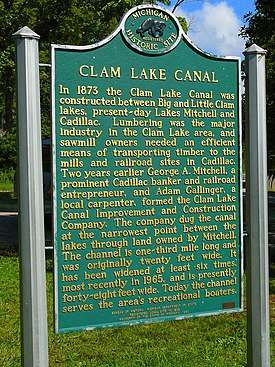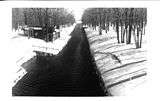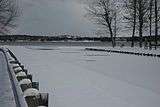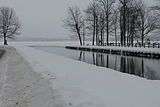Clam Lake Canal
The Clam Lake Canal is a man-made .33 miles (0.53 km) long canal between Lake Mitchell and Lake Cadillac in Cadillac, Michigan. It was made by George A. Mitchell, the founder of the city of Cadillac (as the Village of Clam Lake), in the 1870s. The main purpose of the man-made canal was to facilitate the movement of logs to sawmills. Mitchell was a businessman, merchant, railwayman, lumber baron, and real estate developer who needed lumber to build the village and saw the potential for further sawmill development.
| Clam Lake Canal | |
|---|---|
.jpg) Clam Lake Canal from M-115 (May 2017) | |
 Location within the state of Michigan | |
| Location | Mitchell State Park Cadillac, Michigan |
| Country | |
| Coordinates | 44°14′21.8″N 85°27′12.6″W |
| Specifications | |
| Length | 0.33 miles (0.53 km) |
| Maximum height above sea level | 1,289 ft (393 m) |
| Status | Open |
| Maximum width | 48 feet (14.6 m) |
| History | |
| Former names | Black Creek[1] |
| Modern name | Cadillac Canal[2] |
| Current owner | Michigan DNR |
| Original owner | George A. Mitchell |
| Principal engineer | Clam Lake Improvement and Construction Company |
| Date completed | 1873 |
| Geography | |
| Connects to | Lake Cadillac and Lake Mitchell (originally known as Big Clam Lake and Little Clam Lake) |
| Depth | 2.25 feet (0.69 m) |
| Clam Lake Canal | |
|---|---|
 Clam Lake Canal historic marker | |
| Designated | March 16, 1989 |
Sometimes called the Cadillac Canal, it is primarily used today for recreation boaters travelling between the two lakes. In 1919, the area was reorganized as Mitchell State Park; the canal itself was dedicated as a Michigan State Historic Site on March 16, 1989.[2]
The canal displayed an unusual mystery soon after it was constructed. It was frozen over in the first part of the winter when the lakes on each side of it were unfrozen. Then when the adjacent lakes froze over with thick ice this canal in-between was unfrozen and flowed freely all winter long.[3]
Background
In 1873, George A. Mitchell paid $2,000 ($42,700 today) to purchase a 40 acres (16 ha) strip of land between Little Clam Lake (since renamed Lake Cadillac when the village of Clam Lake was similarly renamed) and Big Clam Lake (since renamed Lake Mitchell, for George's nephew and partner, William W. Mitchell). The strip already connected these lakes via the small Black Creek, which Mitchell envisioned as an efficient transportation route for logs once the canal was constructed.[4][5]
Mitchell first persuaded the Grand Rapids and Indiana Railroad to change their original route layout between the lakes to be redirected to go to the eastern end of the Little Clam Lake in the southeast corner of Wexford County, Michigan.[5] He then formed the Clam Lake Improvement and Construction Company and developed a canal there by widening the stream. There was a construction permit taken out as was required by the state of Michigan.[6] Mitchel widened the .33 miles (0.53 km) long connecting stream to some 20 ft or 6.1 m. The main reason for the canal's development was to be able to float logs from one lake to the other and collect fees for the usage of the waterway.[7] The logs were taken to the railroad and sawmills for processing into lumber.[8] The Clam Lake Canal has been widened additionally six times to about 50 ft or 15 m wide and is used in the present time as a recreational passage between the lakes for the local boaters.[9]
Clam Lake Canal mystery
The Clam Lake Canal displays an unusual event most winters. It is out of the ordinary of what usually happens to canals in the Northern Hemisphere of the world in the winter time where temperatures are consistently well below the freezing point. It is such an unusual event that it has been written up in Ripley's Believe-It-Or-Not books series.[3] The phenomenon is when the canal is frozen over in the first part of the winter, the lakes on each side are unfrozen.[3] The canal freezes over first during the winter months, while the lakes on either end of the canal are unfrozen during a typical winter in Northern Michigan.[3] After the lakes freeze over during the mid-winter months, the canal thaws out and flows with unfrozen water.[3]
According to Department of Natural Resources, the explanation for the canal unfrozen phenomenon concerns the physical properties of water. It starts with the fact that water is heaviest and most dense at 39 degrees Fahrenheit and lighter above and below this temperature because it is less dense. Therefore, in the early winter months, the lighter water molecules float to the top. Then as the weather gets colder the water closest to the top freezes first and turns to ice. In addition, since the canal is shallower and has less volume than the adjoining lakes it freezes quicker, and this is the reason why ice forms on Clam Lake canal before lakes Mitchell and Cadillac. As the winter advances and the temperatures drop more the lakes catch up and start the hard freezing process. The warm water of the lake under the ice is forced to leave as the ice becomes thicker on top. The warm water moves toward the canal, thawing the canal and causing the canal water current to flow. It stays open for the length of the winter. On rare occasions, when the temperature goes below zero Fahrenheit, there will be some ice formed on the shoreline of the canal.[10]
 January 1890 – Clam Lake Canal flows in winter months while the lakes on each side are frozen over
January 1890 – Clam Lake Canal flows in winter months while the lakes on each side are frozen over February 1900 – Clam Lake Canal flows, Lake Cadillac and Mitchell are frozen with thick ice on top
February 1900 – Clam Lake Canal flows, Lake Cadillac and Mitchell are frozen with thick ice on top 11/21/2008 – Widened Clam Lake Canal is frozen, but the lakes on each side are open and unfrozen
11/21/2008 – Widened Clam Lake Canal is frozen, but the lakes on each side are open and unfrozen 12/14/2008 – Lakes are frozen, while Clam Lake Canal itself is flowing and unfrozen in winter
12/14/2008 – Lakes are frozen, while Clam Lake Canal itself is flowing and unfrozen in winter
References
- Cadillac Area Visitors Bureau (December 4, 2015). "2 Lakes, A Canal, A Railroad, & A Bit of History". Retrieved December 29, 2018.
- Cadillac Area Visitors Bureau (2018). "Cadillac Canal". Archived from the original on December 30, 2018. Retrieved December 29, 2018.
- Jager 1995, p. 27.
- Tonello, Mark A. (2012). Lake Mitchell (PDF). Status of the Fishery Resource (Report). Michigan Dept. of Natural Resources. Retrieved 2017-03-02.
- Irish, Brenda (September 1, 2006). "Connected by a Canal". High Beam Research. Michigan History Magazine. Archived from the original on February 13, 2017. Retrieved February 12, 2017.
- "The Legislature". Detroit Free Press. Detroit, Michigan. April 3, 1875 – via newspapers.com

- Peterson, William (June 12, 1971). "Judge tells of county seat battle". Cadillac Evening News. Cadillac, Michigan.
- "Michigan". Cadillac News. Cadillac, Michigan. September 26, 1880 – via Newspapers.com

- Ashlee 2005, p. 518.
- "Clam Lake Canal mystery". Cadillac News. Cadillac, Michigan. December 8, 2006.
Sources
- Ashlee, Laura R. (2005). Guide to Michigan's Historical Markers. Ann Arbor, Michigan U.S: University of Michigan Press. ISBN 0-472-03066-3.CS1 maint: ref=harv (link)
- Jager, Mark (1995). Mystic Michigan: Part One. Marion, Michigan: Zosma Publications. ISBN 9780967246444.
Ever since the canal was constructed in the late 1880s, people have wondered why the canal freezes over when the cold weather comes, while the lakes remain unfrozen. Later, when the lakes freeze over, the canal thaws out and remains unfrozen for the rest of the winter.
CS1 maint: ref=harv (link)
External links
| Wikimedia Commons has media related to Clam Lake Canal. |